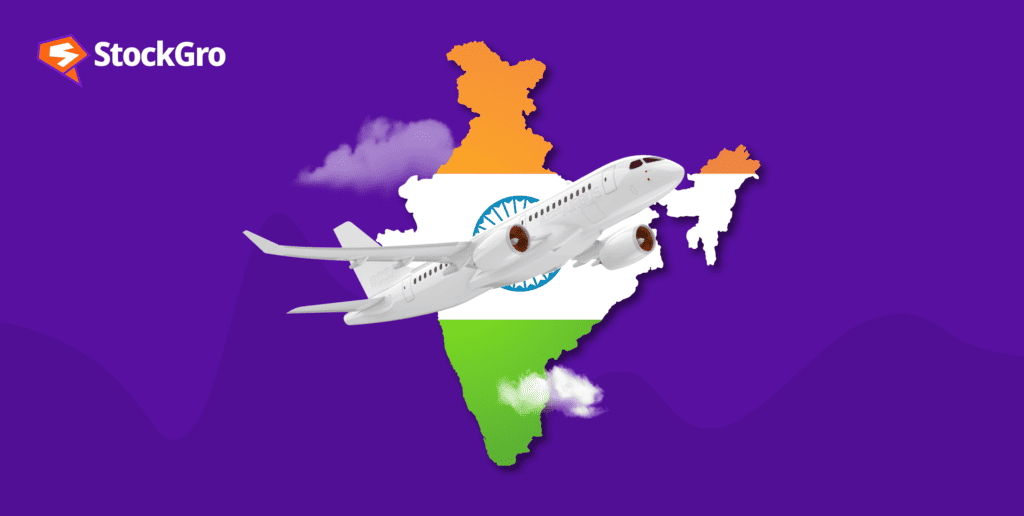
Over the last three years, India’s civil aviation sector has grown at one of the fastest growth rates nationwide. By 2024, India is projected to surpass the UK to take over the third spot in the world rankings for air passengers, climbing to the third biggest domestic aviation market globally.
Top industry experts have said India’s aviation sector has tremendous opportunities waiting to be exploited. Its growth would be supported by a rising middle class and a young population with a stronger tendency to travel.
Keeping that in mind, in today’s article, we will look at the aviation industry in India and where it is headed while focusing on the top stocks to invest in. Let’s begin.
What is the aviation industry in India?
The commercial sector that creates, maintains, and runs airports and aircraft is known as the aviation industry. There are a wide variety of duties in the aviation industry. All the duties that must be completed on the ground before takeoff, during the flight, and after landing are part of the industry.
In general, the aviation sector may be divided into three categories:
- Scheduled air travel (domestic and international airlines)
- Non-scheduled air transportation
- Air taxi operators and air cargo
Although planes and helicopters are the two primary aircraft forms, most contemporary definitions of “aviation” include uncrewed aircraft as well, such as drones. Therefore, any business related to these activities may be referred to as the aviation industry.
Also read: The renewable energy industry in India: A game-changer for the environmenttps
History of aviation industry in India
India’s aviation history began in 1911 when Allahabad saw the establishment of the world’s first airmail service. In 1932, Tata Airlines became the first airline in India.
Following independence in 1947, Tata Airlines went by the name Air India. In 1948, Air India launched its first international route from Mumbai to London. Then, gradually, several newer airlines that served various regions of India were established by 1950.
In 1953, the Indian government nationalised the country’s aviation sector and assumed command of all significant and prominent airlines. The Indian government accordingly combined and strengthened eight important airlines into two carriers. They went under the names Air India and Indian Airlines.
Current aviation industry growth in India
India is predicted to become the third-largest air passenger market in the world by 2030, surpassing both China and the US. Airports in India estimated that in FY24, there would be 76.73 million domestic passengers, up 19.1% YoY compared to the same time the previous year.
Also, in FY23, the air traffic movement was 327.28 million, compared to 188.89 million in FY22. This shows that the Indian aviation sector has mostly recovered from the unexpected onset of the COVID-19 pandemic.
In FY22, the domestic market share of the aviation industry in India was led by IndiGo, while SpiceJet and AirIndia followed, respectively.
| Aviation companies | Domestic market share |
| IndiGo | 55.4% |
| Spicejet | 10% |
| Air India | 9.7% |
| Go Air | 9.5% |
| Vistara | 8% |
| Air Asia | 5.7% |
| Alliance Air | 1.3% |
| Trujet | 0.2% |
| Star Air | 0.2% |
| Others | 0.1% |
As of August 2023, IndiGo maintained its lead position with 63.3% of the market.
The Indian government has been trying to increase the number of airports to accommodate the growing volume of air traffic.
The Airport Authority of India (AAI), working with private companies like GMR Group and Adani Group, oversees airports in India. India has 148 airports in use as of 2023. The Indian government has set a target of 220 operable airports by 2025.
Also, the Indian government launched the National Civil Aviation Policy 2016 (NCAP), a programme to improve domestic travel experiences by offering reliable air connections. This is particularly beneficial for consumers who want to explore lesser-known destinations.
One essential element of NCAP 2016 is the Regional Connectivity Scheme, often known as UDAN (Ude Desh ka Aam Nagrik). For 2023–2024, US$14.98 million has been allotted to UDAN. By 2024, the government intends to implement 1,000 UDAN lines.
Freight traffic also grew from 2.70 MMT to 3.15 MMT at a CAGR of 2.20% between FY16 and FY23. In FY23, 3.15 million metric tonnes of goods were moved. By FY40, airport freight traffic in India might potentially exceed 17 MT.
India has the necessary strategy and vision for the sector’s fast economic expansion, as stated by the International Air Transport Association (IATA).
Also read: The role of the energy sector in powering India’s growth
The future of the aviation industry in India
Since most Indians still find flights expensive, especially the middle class, which makes up almost 40% of the population, air transport remains mostly unexplored despite its enormous growth potential.
However, the government has played a crucial role in creating policies supporting the aviation industry over the years. For example, the government has launched the UDAN-RCS initiative, which intends to boost air connectivity by offering reasonably priced, commercially practical, and profitable travel on regional airlines.
India’s travel and tourism industry contributed US$190 billion to the country’s GDP in 2022. According to figures issued by the World Travel & Tourism Council (WTTC), it would be valued at US$ 200 billion by the end of this year. Over the next ten years, the estimated value is a staggering US$450 billion.
Due to growing air travel demand, India will require 2,380 additional commercial aircraft by 2038. The travel industry in India, estimated to be worth around US$75 billion in FY20, is expected to surpass US$125 billion by FY27.
The top companies in the civil aviation industry in India
Below is a list of the top aviation stocks ranked by market cap on the BSE as of December 15, 2023.
| Company | Last price (₹) | Market capitalisation (₹ cr) |
| Interglobe Aviation Ltd. | 2914.40 | 112,479 |
| SpiceJet Ltd. | 53.58 | 3,665 |
| Jet Airways Ltd. | 58.60 | 665 |
| Global Vectra Helicorp Ltd. | 110.30 | 154 |
Also read: Maritime industry: How India’s shipping and port industry is making wavesttps
Conclusion
The aviation industry is one of the lucrative sectors that promises tremendous growth potential with high returns and many opportunities ahead. Being the third-largest market in the industry globally, India’s aviation sector is overflowing with innovation, strength, and ventures.
Keeping this in mind, the industry offers a unique value proposition, which might be a major green signal for potential investors in the future.

